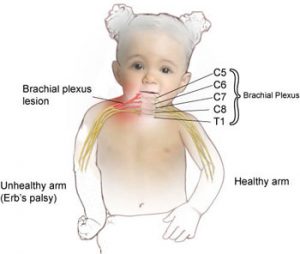Musculoskeletal Development
Understanding Mechanobiological Effects of Peripheral Nerve Injury on Developing Bone and Muscle
Collaboration with Dr. Katherine Saul, Mechanical & Aerospace Engineering, NC State
Brachial Plexus Birth Injury (BPBI), a peripheral nerve injury that affects 1 in 1,000 births annually, causes impaired function of the neonatal upper limb. Despite physical therapy and surgical interventions, the resulting denervation of muscle following injury often causes gross morphological changes in the glenohumeral joint, presenting as osseous (e.g. glenoid retroversion, humeral head subluxation) and postural deformities (e.g. internal shoulder rotation contracture).
Effects to bone due to altered musculoskeletal loading following nerve injury requires an in-depth understanding of changes in bone mineralization and microstructure in developing joints, which is currently not well understood. We use a rat model to determine BPBI-related changes in bone structure and metabolism in the proximal humerus and distal scapula during development using micro-computed tomography and histology. While the etiology of osseous deformity in BPBI remains unclear, understanding changes in bone microstructure and metabolism resulting from injury may present a foundation for understanding the progression of deformity and offer targets for interventions and treatments.


Selected Publications and Presentations:
- Steven A. Thompson, Kyla B. Bosh, Katherine R. Saul, Jacqueline H. Cole. “Assessing functional limb usage in a rat model of brachial plexus birth injury.” North American Congress on Biomechanics Aug 21-25, 2022 (poster)
- Kyla B. Bosh, Jennifer R. Potts, Kerry A. Danelson, Katherine R. Saul, Jacqueline H. Cole. “Early alterations in forelimb grip strength and gait following brachial plexus birth injury” North American Congress on Biomechanics, Aug 21-25, 2022 (poster)
- Jennifer R. Potts, Kyla B. Bosh, Katherine R. Saul, Jacqueline H. Cole. “Altered Gait and Grip Strength Following Brachial Plexus Birth Injury” National Conference on Undergraduate Research @ Home, Apr 4-8, 2022 (oral)
- Fawcett EB*, McCormick CM*, Murray AF, Crouch DL, Saul KR, Cole JH. Characterizing trabecular bone properties near the glenohumeral joint following brachial plexus birth injury. bioRxiv preprint. [DOI: 10.1101/967224]. Under Review. * co-first authors
- Tushak SK*, Tamburro MK*, Fawcett EB, Merritt LE, Saul KR, Cole JH. Forelimb disuse impairs glenohumeral muscle development in growing rats. bioRxiv preprint. [DOI: 10.1101/967273]. Under Review. * co-first authors
- Merritt LE, Tamburro MK, Tushak SK, Fawcett EB, Cole JH, Saul KR. Forelimb unloading impairs glenohumeral bone development in growing rats. Under Review at Journal of Orthopaedic Research.
- Dixit NN, McCormick CM, Cole JH, Saul KR (2021). Influence of brachial plexus birth injury location on glenohumeral joint morphology. The Journal of Hand Surgery 46(6):512.e1-512.e9. DOI: 10.1016/j.jhsa.2020.10.019. PMID: 33358583.
- Dixit NN, McCormick CM, Warren E, Cole JH, Saul KR (2021). Preganglionic and postganglionic brachial plexus birth injury effects on shoulder muscle growth. The Journal of Hand Surgery 46(2): 146.e1-146.e9. DOI: 10.1016/j.jhsa.2020.07.017. PMID: 32919794.
- Fawcett EB, Merritt LE, Dixit NN, Saul KR, Cole JH (2020) Adaptations in trabecular bone microstructure following brachial plexus birth injury are not due solely to limb disuse. American Society of Biomechanics Annual Meeting, Atlanta, GA, Aug 4-7, (poster)
- Dixit NN, McFarland DC, Fisher MB, Cole JH, Saul KR (2020). Integrated iterative musculoskeletal modeling predicts bone morphology following brachial plexus birth injury (BPBI). Journal of Biomechanics 103:109658. DOI: 10.1016/j.jbiomech.2020.109658. PMID: 32089271.
This work was funded by the National Institutes of Health (R01HD101406) and the NC State Office of Undergraduate Research.
